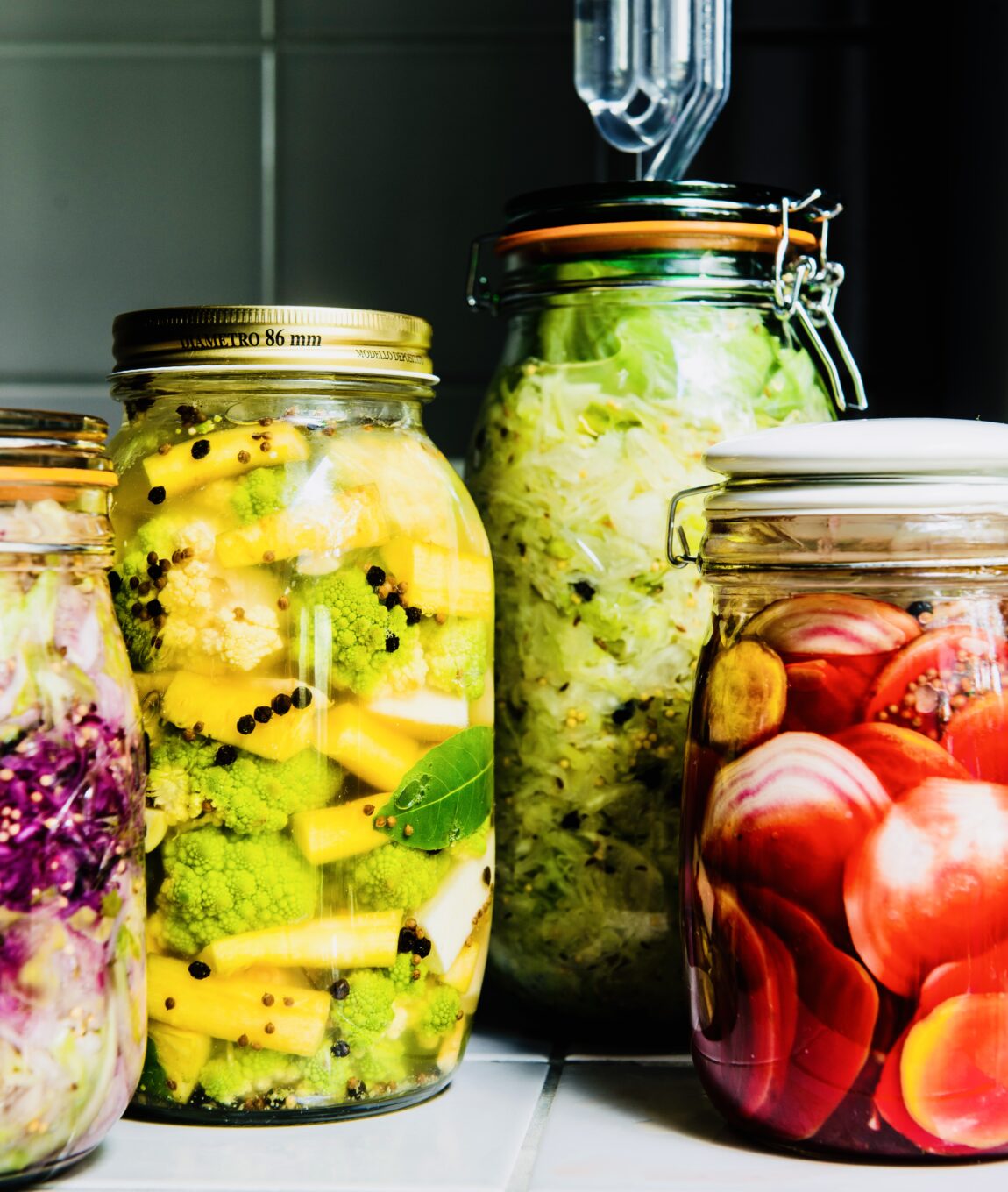Milk kefir: what it is and how to make it (including recipe)
Category: fermentation,Learn
Kefir, or more specifically milk kefir, is a unique fermented dairy drink. In this blog post, we dive into the world of milk kefir: what it is, how to make it and how it differs from other (dairy) beverages. And of course, how to make it yourself. So we end with a recipe for making milkkefir yourself

WHAT IS MILK KEFIR?
Milk kefir is a fresh, slightly tingly, probiotic dairy drink. It’s also reffered to simply as: kefir, or sometimes kefir yoghurt. The drinking yogurt can be purchased, but most people make it themselves. It is full of vitamins and minerals and essential amino acids. In addition, milk kefir is easily digestible due to a large amount of right-turning lactic acid bacteria. It is also very healthy. And of course, it’s also just really tasty.
what are the origins of milk kefir?
Milk kefir, or kefir yoghurt, as with so many fermentation methods, seems to have originated by accident. Presumably by sheep and goat herders in the North Caucasus who hung their sheep-leather milk bags not properly cleaned in the sun. But the story also goes that Muhammad (yes that one) came to bring the drink there personally. As a gift, because that’s how He is.

WHAT DOES MILK KEFIR TASTE LIKE?
The taste of milk kefir can range from mild and creamy to tangy and sour, depending on the fermentation time. It has a natural, fresh taste, sometimes described as a cross between yogurt and buttermilk. The consistency of milk kefir is also somewhere between yogurt and buttermilk. The taste a bit more mature (cheesier, if you will) and the dairy drink, unlike its braver yogurt brothers, contains both pungency and a little bit of alcohol.
WHAT IS THE DIFFERENCE BETWEEN MILK KEFIR AND YOGURT?
Milk kefir and yogurt are both fermented dairy products, but there are some important differences in both the preparation process, taste, and nutritional value. Milk kefir is made with so-called milk kefir grains, which contain a rich symbiotic culture of bacteria and yeasts. This results in a drink with a wide variety of probiotics and a slightly effervescent mouthfeel. Milk kefir is generally a bit thinner than yogurt and has a sharper, sometimes even slightly cheesy and slightly alcoholic taste.
Yogurt, on the other hand, is made by fermenting milk with specific yogurt cultures, usually consisting of only two microbes: Lactobacillus bulgaricus and Streptococcus thermophilus. This results in a thicker product with a milder taste and creamier texture.
Although both dairy products are high in nutrients such as calcium and protein, milk kefir offers a greater variety of probiotics. But, the taste is also more pronounced. So, it is mostly a matter of preference.
WHAT IS THE DIFFERENCE BETWEEN MILK KEFIR AND WATER KEFIR?
Although the products share the same name, are made with “grains” and are both tasty healthy, fermented drinks, that’s where the similarity ends.
Milk kefir is made with milk kefir grains and milk, and is thus a dairy drink. Water kefir (also known as “tibicos”) is made with water kefir grains and a sugar water solution, sometimes supplemented with fruit or fruit juices. It is thus a soft drink. So they are totally different beverages.
THE MICROBIOLOGY OF MILK KEFIR
Milk kefir’s unique properties are due to the complex symbiotic relationship between the various microorganisms in the kefir grains. These grains, which look like out gelatinous cauliflower florets, contain a rich mix of bacteria and yeasts that work together to ferment milk. Like kombucha, you can call this mix of microbes a “SCOBY”: a Symbiotic Culture of Bacteria and Yeast. They contain more than 10 different yeasts living in symbiosis. The lactic acid bacteria predominate.
Some of the main strains of bacteria in milk kefir are Lactobacillus acidophilus, Lactobacillus casei and Lactococcus lactis, which help convert lactose into lactic acid. This contributes to the characteristic sour taste of milk kefir.
In addition, milk kefir contains yeasts such as Saccharomyces cerevisiae and Kluyveromyces marxianus, which are responsible for producing a small amount of alcohol and carbon dioxide, which gives milk kefir its slightly effervescent texture.
Another important component of milk kefir is kefiran, a polysaccharide produced by certain lactobacilli in the kefir grains. It gives structure to the grains. Kefiran also contributes to the creamy texture of milk kefir.

does milk kefir contain alcohol?
Milk kefir grains contain yeasts, which provide the slight tingle and a little alcohol in your favorite dairy drink. In terms of intoxication potential, you shouldn’t think too much of it. The alcohol content is between 0.1 and 2%, and only in exceptional cases.
IS MILK KEFIR HEALTHY?

Online, you will read a lot about the health benefits of milk kefir. But, what of this is really true? Recent research shows that milk kefir can offer several benefits.
Kefiran is known for its health-promoting properties, including antibacterial activity and potentially beneficial effects on the immune and digestive systems.
Milk kefir is rich in probiotics due to the presence of various bacteria and yeasts, which contributes to healthy intestinal flora and digestion. This probiotic action can help improve lactose tolerance, which is especially beneficial for people with lactose intolerance. The fermentation process also reduces the amount of lactose (or milk sugars) in milk, another reason why milk kefir may be more suitable than milk for people with lactose intolerance.
In addition, milk kefir has antimicrobial properties. The microorganisms present, such as Lactococcus lactis, produce substances such as hydrogen peroxide and bacteriocins, which can inhibit pathogenic bacteria. This makes milk kefir potentially useful in fighting various types of infections.
There is also evidence that milk kefir may play a role in lowering cholesterol. Studies in animals have shown that consumption of kefir can lead to a reduction in total serum cholesterol and triglycerides. This effect could contribute to improved heart health, although more studies in humans are needed to confirm these results.
Interestingly, milk kefir may also have anti-carcinogenic properties. Research shows that certain components in kefir, including kefiran, can inhibit the growth of cancer cells, although this has been demonstrated mainly in animal studies and in test tubes. This suggests that milk kefir may be potentially protective against certain cancers.
In summary, milk kefir is definitely a very healthy drink, with a lot of potential. Keep in mind, however, that much of the potential is still in the early stages of research. So in case of illness, always consult your doctor first and don’t start using milk kefir to try to cure your illness.
WHAT ARE MILK KEFIR GRAINS?

Kefir is made using kefir grains that are somewhat reminiscent of cauliflower florets in shape. Like kombucha and water kefir grains, milk kefir grains are a SCOBY (symbiotic colony of bacteria and yeasts). At room temperature and sufficient nutrients, the grains double in size in about two weeks to spongy white balls which is why they are also called, wrongly, yogurt plants or yogurt flowers.
So, if you want to make milk kefir the traditional way, you need these milk kefir grains
WHAT’S THE DIFFERENCE BETWEEN HOMEMADE AND SUPERMARKET KEFIR?
Recent scientific research confirms what Dutch consumer investigations program ‘De Keuringsdienst van Waarde’ discovered in 2019: they’re fundamentally different products.
Microbial Composition: The Core Difference
Traditional kefir made with kefir grains contains up to 60-70 different microorganisms in complex symbiotic relationships. Store-bought kefir uses only 7-9 defined starter cultures and often completely lacks characteristic yeast populations. While authentic kefir contains Lactobacillus kefiranofaciens (responsible for healthy kefiran polysaccharides), commercial products use standard dairy starters like Lactococcus lactis.
The biggest difference? Yeasts. Traditional kefir contains complex yeast communities including Kluyveromyces marxianus and Saccharomyces cerevisiae. Laboratory tests show most commercial kefir contains no yeasts at all—technically making them acidified milk products rather than true kefir.
Is Store-Bought Kefir Healthy?
Commercial kefir offers health benefits as a fermented dairy product, but clinical research consistently shows better results for traditional kefir. A 2023 study found only traditional kefir significantly lowered LDL cholesterol and inflammatory markers, with superior gut microbiome modulation.
The conclusion: for maximum health benefits and authentic kefir experience, homemade with real kefir grains is the clear winner.

FREQUENTLY ASKED QUESTIONS ABOUT MAKING MILK KEFIR
preparation
1. Take a liter of full-fat milk and add 50 grams (two tablespoons) of fresh kefir flowers to it (but somewhere between 2 and 10% is good).
2. Let the milk ferment, covered, for 24-48 hours at room temperature in a jar, container, bottle or otherwise.
3. If you want bubbles in your kefir, use a sealable container (such as a plastic milk bottle) so the carbon dioxide cannot escape. If you prefer flat kefir, then covering with a handkerchief, tea towel, loose lid or loosely laid plastic wrap will suffice.
4. Shake or stir the kefir gently a few times during fermentation.
5. Remove the kefir florets by pouring the kefir through a strainer. You can store the grains in some milk, or freeze, dry or of course just make new kefir with them.
6. Intermediate rinsing with water is done by some, but is not necessarily necessary. It does help to get the yogurt off the grains.
7. Optional: leave sealed for a few more hours or a day to fully re-pressurize and prick.
8. Chill the kefir in the refrigerator.
Enjoy.
Want to learn more? Take our milk kefir course
Learn to make milk kefir in this online course with fermentation expert Meneer Wateetons. Milk kefir is a fresh, fizzy, easily digestible, and above all, delicious probiotic dairy drink. In this online workshop, you’ll learn exactly how milk kefir fermentation works, how to obtain and maintain the grains, and how to make delicious milk kefir for the rest of your life.

About the author (Meneer Wateetons)
Meneer Wateetons (a pseudonym derived from the name of his blog, which literally means ‘Mr. what-eats-us’) is a renowned Dutch food writer, PhD scientist, teacher, fermentation expert, sausage maker, and the owner of startercultures.eu. He has written nine books on culinary topics such as fermentation, alcohol production, sausage and charcuterie making, and deep-frying. Through his books, (online) courses, and corporate trainings, he has shared his knowledge with countless hobby cooks, chefs, and food professionals. Learn more about Meneer Wateetons.
Related Posts

How to make cheese (including a recipe)
How do you make cheese? In this blog post we will teach you the basics of cheese making, including a recipe for your first Gouda style cheese!

How to make your own real fermented pickles
Learn how to make your own crunchy fermented pickles. Easy recipe with tips, variations, and answers to common questions.

How to Ferment Vegetables: A Beginner’s Step-by-Step Guide
Learn the simple art of vegetable fermentation. This guide covers the science, the right salt ratio, and includes an easy sauerkraut recipe to start your first successful ferment today.





